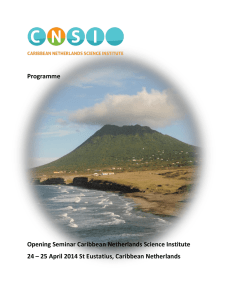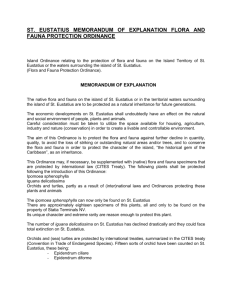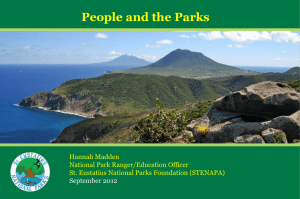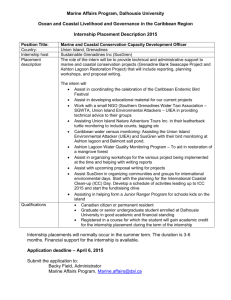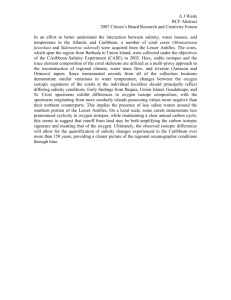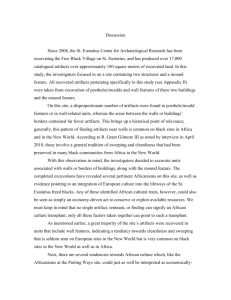St Eustatius
advertisement
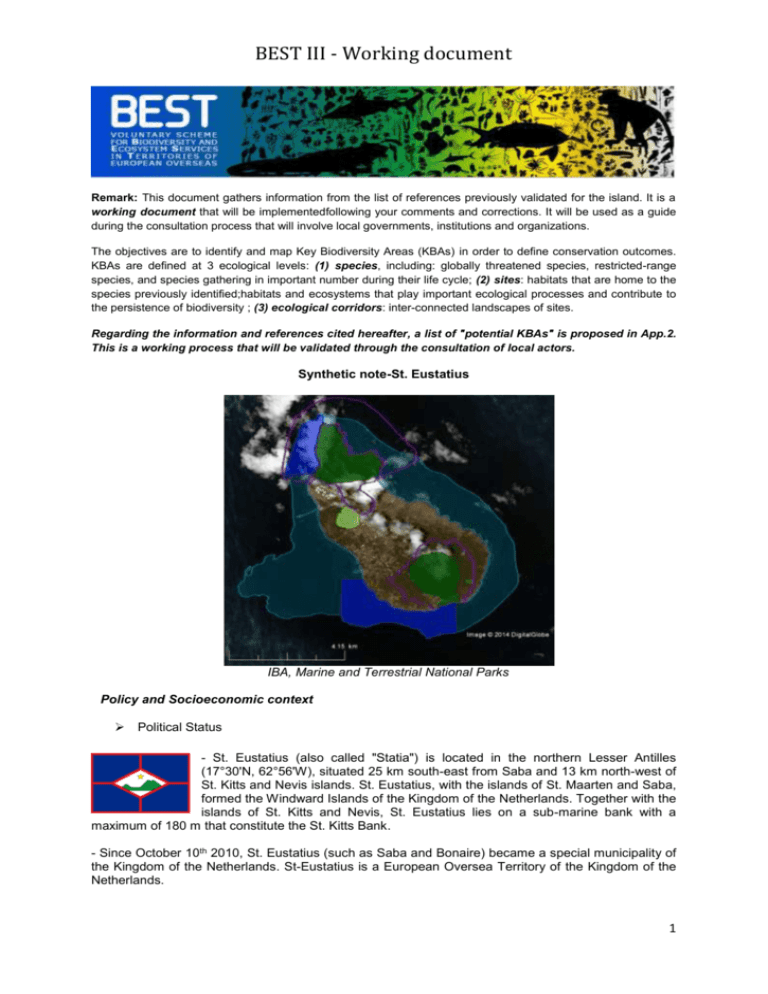
BEST III - Working document Remark: This document gathers information from the list of references previously validated for the island. It is a working document that will be implementedfollowing your comments and corrections. It will be used as a guide during the consultation process that will involve local governments, institutions and organizations. The objectives are to identify and map Key Biodiversity Areas (KBAs) in order to define conservation outcomes. KBAs are defined at 3 ecological levels: (1) species, including: globally threatened species, restricted-range species, and species gathering in important number during their life cycle; (2) sites: habitats that are home to the species previously identified;habitats and ecosystems that play important ecological processes and contribute to the persistence of biodiversity ; (3) ecological corridors: inter-connected landscapes of sites. Regarding the information and references cited hereafter, a list of "potential KBAs" is proposed in App.2. This is a working process that will be validated through the consultation of local actors. Synthetic note-St. Eustatius IBA, Marine and Terrestrial National Parks Policy and Socioeconomic context Political Status - St. Eustatius (also called "Statia") is located in the northern Lesser Antilles (17°30'N, 62°56'W), situated 25 km south-east from Saba and 13 km north-west of St. Kitts and Nevis islands. St. Eustatius, with the islands of St. Maarten and Saba, formed the Windward Islands of the Kingdom of the Netherlands. Together with the islands of St. Kitts and Nevis, St. Eustatius lies on a sub-marine bank with a maximum of 180 m that constitute the St. Kitts Bank. - Since October 10th 2010, St. Eustatius (such as Saba and Bonaire) became a special municipality of the Kingdom of the Netherlands. St-Eustatius is a European Oversea Territory of the Kingdom of the Netherlands. 1 BEST III - Working document Demographic Trends and Socio-economic context(Central Bureau Statistics - Caribbean Netherlands 2012): - Area:21 km² - EEZ: 2,281 km², EEZ of the Dutch Windward Islands: 12414 km² - Population: 3,897 inhab., density: 186 inhab./km² - GDP ($/ inhab.): 24,800 - Main economic activities: oil storage and trans-shipment facilities; tourism, with associated services and construction industries. Protected and/or managed areas (References: DCNA 2012a, MacRae and Esteban 2007, 2009) List of protected areas - Quill/Boven National Park (created in 1997 over 540 ha) consists of 2 sub-sectors: the Quill mountain (220 ha, everything above 205 m is protected), a dormant volcano of 602 m located in thesouthern part of the island; Boven sector (320 ha) located on the northern tip of the island (also called The Mountains). Accross Boven sector, 4 hills are on government lands (Boven, Bergje, Venus and Gilboa) and Signal Hill is within private property of Statia Oil Terminal. These National Parks cover about 25% of land area of the island. - St. Eustatius National Marine Park (created in 1996 over 2750 ha) comprises a marine park around the entire island (from high-tidemark to 30m deep) and 2 managed marine reserves (no-take zones where fishing and anchoring are prohibited).These 2 no-take zones were established to promote dive tourism and sustainable fisheries. Scuba-diving and mooring fees support the administration and management of the Marine Park. The marine park falls entirely within the territorial waters and jurisdiction of St. Eustatius and is protected by the Marine Environment Ordinance (1996). The National Parks are actively managed by a local NGO called St.Eustatius National Parks Foundation (STENAPA). STENAPA also manages the Miriam Schmidt Botanical Garden (5.3 ha) that is adjacent to the southern slopes of the Quill National Park. The land is leased by the Island Government to STENAPA and is not subject to any regulations. A fence prevents entry by roaming goats and cows (MacRae and Esteban 2009). On-going projects - Projects under study - Designation of a shark and marine mammal sanctuary in the Caribbean waters of the Kingdom of the Netherlands (Dutch Caribbean Nature Policy Plan 2013-2017, Project "Save our sharks", Debrot et al. 2011). Establishment of a Dutch Caribbean Shark National Plan Of Action (van Beek et al. 2014). - Tropicbird monitoring (2012 to present) and the impact of introduced species on breeding success (Madden and Ellis 2013, Madden 2014, Robertson and Madden 2015, ongoing) - Iguana delicatissima conservation (awareness, genetic diversity and small-scale local projects, ongoing) (Docherty 2014, Brouwers 2015, van den Burg 2015) - Bridled Quail-dove population assessment (ongoing, McLaughlin 2014, Madden 2015) - Impact of roaming animals within the Quill National Park (Madden 2013, 2014, ongoing) - Checklist of the Flora of St. Eustatius (Axelrod, not yet published) - Terrestrial bird monitoring (2009-present, ongoing) - Butterfly monitoring (2009-present, ongoing, Madden, Debrot et al., not yet published) - Removal of free roaming cattle program started in 2013 with funding from the Dutch government. The objective is to reduce the number of free roaming cattle (in 2014 estimated at about 500 head) to a manageable number over a three year period. Action, management plans& Programs - St. Eustatius Marine Park Management Plan 2007 (MacRae and Esteban 2007) - The Quill/Boven National Park and Miriam Schmidt Botanical Garden Management Plan 2009 (MacRae and Esteban 2009) - St. Eustatius National Marine Park Lionfish Response Plan (Bervoets 2009) - Management Plan for the natural resources of the EEZ of the Dutch Caribbean (Meesters et al. 2010) 2 BEST III - Working document - St. Eustatius Sea Turtle Conservation Program coordinated by STENAPA and affiliated with WIDECAST (Wider Caribbean Sea Turtle Conservation Network) (Berkel 2013) - STENAPA International Programs: the Intern Program (since 2001, interns help accomplishing projects at the Botanical Garden and the 2 National Parks); Working Abroad Program (international networking service based in the UK that has established since 2003 volunteer projects in Statia). - STENAPA educational programs: Snorkel Club, Junior Ranger Club Biological importance of the ecosystems Species outcomes List of Taxa assessed as globally threatened (IUCN Red List). List of species are indicated in Appendix 1. Taxonomic Group Plants Invertebrates Critically endangered - Corals 2 Fishes Sharks and Rays Reptiles Endangered Vulnerable 3 1 2 5 1 12 2 (occ.) 3 (+ 2 occ.) 2 (occ.) 1 (occ.) Birds Mammals - Bats - Marine mammals Total 1 (occ.) 3 9 (+ 4 occ.) SPAW Protocol A. III (1) Total A.II (4), A.III (25) 9 3 13 A.II (5), A.III (1) A.II (2) A.II (3) A.II (8) (4 occ.) 4 (+ 3 occ.) 1 occ. 17 (+ 4 occ.) List of species geographically restricted (References: Collier and Brown 2009, DCNA 2012b, Bland and Desutter-Grandcolas 2003, Kringsand Axelrod 2013,Morpeth 2011, New York Botanical Garden database, Rojer 1997, Sastre et Breuil 2007, Sipman 2009,Powell et al. 2005, Terueland Madden 2012) Taxonomic group Plants Invertebrates - Arachnids - Insects Amphibians Reptiles Number of endemic species - 2 plant species endemic to St. Eustatius: Statia Morning Glory (Ipomoea sphenophylla), Gonolobus aloiensis - 1 lichen endemic to St. Eustatius (Eremothecella microcephalica) - 18 plant species restricted to the Lesser Antilles and the Virgin Islands, including 5 plant species limited only to few islands - 1 pseudoscorpion endemic to St Eustatius (Pachyolpium confusum) - 3 arachnids endemic of the Lesser Antilles (2 scorpions: Centruroides barbudensis, Oiclus purvesii, 1 amblypygid species: Phrynus goesii) - 1 butterfly species endemic to the Lesser Antilles: Urbanus obscurus - 9 Orthoptera endemic to the Lesser Antilles, including 1 endemic to Statia (Lactista eustatia) and 5 that may be endemic to Statia(Orocharis minutus, O. proalbifrons, Orochirus maculatus, Cycloptilum eustatiensis, Cyrtoxipha orientalis) - 2 bees restricted to the Lesser Antilles, with one species endemic to Statia and St. Kitts & Nevis islands (Anthophora eustatiensis) - 1 species endemic to few islands of the Lesser Antilles, but exotic in Statia (Caribbean tree frog Eleutherodactylus johnstonei) - 6 species restricted to a few islands in the Lesser Antilles: Lesser Antillean Iguana (Iguana delicatissima), Green Tree Lizard (Anolis bimaculatus), Red-faced ground lizard (Ameiva erythrocephala), Least Island Gecko (Sphaerodactylus sputator), Saba dwarf gecko (S. sabanus), Red-bellied Racer Snake(Alsophis rufiventris) 3 BEST III - Working document Birds Mammals - 9 bird species restricted to the Lesser Antilles and Puerto Rico (Elaenia martinica,Cinclocerthia ruficauda, Margarops fuscus, Margarops fuscatus, Geotrygon mystacea, Orthorynchus cristatus, Eulampis jugularis, E. holosericeus, Loxigilla noctis) - 2 bat species restricted to the Lesser Antilles and Puerto Rico: Antillean Fruiteating Bat (Brachyphylla cavernarum),Tree Bat (Ardops nichollsi) Total Species aggregations / List of species occurring at key stages of their life-cycles - The red billed Tropicbird (Phaethon aethereus) constitutes the island's only breeding seabird population and can be observed flying around the cliffs of Boven IBA (about 200 ind., Collier and Brown 2009). Habitat outcomes Terrestrial areas - 3 types of landscapes: northwest hilly area, the flat center called "The Kultuurvlakte", the southern part with the volcano. - The Quill/Boven National Park encompasses a high biodiversity of plant species (the inventory of Rojer (1997) recorded about 482 wild plant species). About 18 plant species (3.7%) are endemic to the Lesser Antilles and Virgin Islands, 5 plant species have a distribution limited to only few islands and 3 plant species are endemic of Statia (Ipomoea sphenophylla, Gonolobus aloiensis, Eremothecella microcephalica) (Krings and Axelrod 2013, Rojer 1997, Sipman 2009). Of the 141 orchid species known in the Lesser Antilles and eastern Caribbean region, 16 can be found on Statia (Rojer 1997, to update with Axelrod's checklist that will be published). - The 2 national parks protect biologically diverse semi-tropical rainforests, pioneer forests, montane thickets and evergreen seasonal forests and include about 67% of the island's remaining dry forests (de Freitas et al. 2012). - The terrestrial National Parks are home and migratory breeding sitesto numerousspecies that are either globally threatened and/or restricted to the Lesser Antilles region, such as: bird species restricted to the Lesser Antilles and Puerto Rico area, the endangered Lesser Antillean Iguana (endemic to few LA islands) and Red-billed Racer snake (endemic to Statia and Saba islands). Both terrestrial parks are internationally recognized as IBAs and SPAW areas. - One of Statia’s endemic species, Ipomoea sphenophylla, occurs in the northern hills (Signal Hill, Gilboa Hill, Bergje), in a dry deciduous seasonal forest that de Freitas et al. (2012) called "PisoniaJusticia " vegetation type.Over 50 specimens have been recorded on the northwest side of Mary's Glory and on the property of the oil Terminal (north-west part of the island) (Rojer 1997, Bush and Madden 2012). Most of the plants occurin the National Park or outside the property of the oil facility (Bush and Madden 2012). - Statia's second endemic plant, Gonolobus aloiensis, occurs in the inner slopes of the Quill National Park (from 200 to 400 m high). This species has been collected only three times and it is therefore difficult to estimate the extent of this population. Main threats are goats and potential activity of the volcano that is presently in a state of dormancy (Krings and Axelrod 2013). - The endangered plant species, Guaiacum officinale, occurs along Oranje Bay, in Orenjestad and few specimens in Old Church graveyard (Madden Hannah, personal communication 2015). - Cliffs, beaches and rocky shores: Almost the entire island is surrounded by sheer cliff coast. "White-Wall"is a limestone formation on the southern slope of the Quill that drops down to the sea. - There are no ponds, wetlands or mangroves on the island. 4 BEST III - Working document Habitats for reptiles - Of the 6 Dutch Caribbean islands, the endangered Iguana delicatissima is found only on Statia (Debrot et al. 2013). - A recent assessment of population status and densities of the endangered I.delicatissima recorded 22 specimens for an overall density of 0.35 iguana/ha that represents 0.5-1% of densities documented for healthy populations. This species seems to be widely distributed on the island but its favorite habitat consists of 2 areas: the vegetated and boulder-strewn slopes between Northern hills and Central plains (from Signal Hills to Gilboa, av. densities of 1.38 iguanas/ha);and the area along North-Western lower flanks of the Quill and the escarpment and cliffs between Oranjestad harbor and the town above the cliffs (av. 2 ig/ha) (Debrot et al. 2013, Debrot and Boman 2013). - Population densities have declined across all habitats since the 2004 assessment during which about 425 animals were recorded (Fogarty et al. 2004). Main threats are the lack of nesting habitats and high mortalities of iguanas due to anthropogenic impacts (entanglement in fencing, invasive species) (Debrot et al. 2013). The loss of suitable nesting habitats may also partly be due to the expansion of the invasive plant (Antigonon leptopus), also known as "Corallita" (Debrot et al. 2013). - Presently there areno Green iguanas nor Mongooses on Statia, but these invasive species occuron neighboring islands (i.e. Saba, St. Kitts, St. Maarten). The regular inter-island traffic between islands represents a major risk for the introduction of these exotic species. Legislation is thus urgently needed to prevent the importation of these 2 invasive species that are known to be responsible of the decline of I.delicatissima populations on other islands (Debrot et al. 2013). Coastal areas: sea turtle nesting areas - The green (149 tracks in 2012) and hawksbill (49 tracks) sea turtles regularly nest on Statia's beaches, whereas the leatherback sea turtle is more occasional (4 nests recorded in 2012) (Berkel 2013). - Among the 8 beaches surveyed in 2012for sea turtle nesting activities, Zeelandia and Turtle beaches encompassed 123 and 27 tracks, respectively (Berkel 2013). - Zeelandia beach is the primary turtle nesting beach hosting the 4 species of sea turtles (Berkel 2013), with the leatherback and loggerhead being occasional species. This nesting site is particularly important for green (45 nests) and hawksbill (16 nests) sea turtles (Berkel 2013). - Few nesting activities occurred on Oranjebaai beach due to the passing traffic, street lights and near shore restaurants and terraces (Berkel 2013). - Monitoring of sea turtles foraging areas indicate that green (mostly juveniles) and hawksbill turtles were often observed on the wrecks in the Marine Park and secondly on reefs (Berkel 2013). Green turtles are particularly abundant over seagrass beds of the site called "general used area" that is the most developed area on the island (with the harbor, city pier, Blue jetty, Terminal jetty, Tumble Down Dick Bay harbor) (Maitz 2011, Smith 2008). Hawksbill turtles seem to be more common around southern Caribbean and northern Atlantic coral reefs (Smith 2008). - A wreck called "Chien Tong", located in the general use area, constitutes an important sleeping site for marine sea turtles. During 2 night dives, 40 different sea turtles occurred on this site (Jessica Berkel, pers. comm. 2015). Marine areas - Coral reefs and seagrass beds surround much of the island (MacRae and Esteban 2007, 2009). The Caribbean side of the Marine Park has a higher percentage of continuous reefs as well as artificial wrecks. - The Southern marine reserve has "lava fingers" formations that are ancient lava flows from Quill volcano. These coral fingers formations form divided spur and groove system that are separated by sandy channels. Patch reefs settled on volcanic boulders mainly occur on the Marine Park (MacRae and Esteban 2007). The 2 Marine Reserves have 43% of hard coral cover and constitute a habitat 5 BEST III - Working document for several IUCN RedList species: 9 coral species, 13 fish species, 4 shark and ray species, 2 sea turtle species (and 3 sea turtle species more occasional), 1 marine mammal (occasional species). The 2 MR contain the main concentrations of coral reef and seagrass habitats: coral reefs are essentially distributed to the southern and south-western island shelf areas, whereas seagrass beds are confined to the northern island shelf area (Debrot et al. 2014). - The economic valuation of St. Eustatius' coral reefs outlines that this ecosystem provides important goods and services for the economy of the island. The revenue generated by this natural resource through coral reef associated tourism and fishery was evaluated in 2009 at about 11,200,545 $ USD (Bervoets 2010). - Seagrass beds and coral reefs occur all around the island. The deep distribution of seagrass beds and their quite sparse biotic coverage may have an impact on the relative importance of this habitat as a nursery area (Debrot et al. 2014). Dense patch reefs occur in the north-western and southwestern areas. Seagrass beds and coral reefs are inter connected - Hurricane Lenny in 1999 and the major bleaching event of 2005 significantly impacted the coral reefs with a loss up to 22% hard coral in the southern marine reserve (Mushroom Garden) (MacRae and Esteban 2007). - A significant decline in seagrass beds cover has been observed since the mid 1990s due to hurricane impacts and anthropogenic activities (anchor damages, extension of the oil Terminal and city pier induce a change of in-shore currents affecting erosion and sand deposit (MacRae and Esteban 2007). - Fish surveys indicated an increase of fish abundance, biomass and diversity within the marine reserves,with the presence of globally threatened species (such as Serranidae species and Lutjanus cyanopterus) (White et al. 2006). The southern marine reserve has the most abundant fish population and a diversity up to 75 fish species (White et al. 2006, McClellan 2009). - Queen conch stock (Lobatus gigas listed on A. III of SPAW Protocol) was estimated to be 184,100 in the 2,700 ha of the Marine Park, with higher abundance on relative deep rubble habitats (17-31m) (Meijer 2014). Important Bird Areas (IBAs) (References:Brown et al. 2009, Collier and Brown 2009) - Of the 54 bird species recorded on the island, 26 species breed and 28 are Neotropical migratory birds. However, Statia is too small to hold significant population of these migrant species. - 2 IBAs are identified (1486 ha): the Quill IBA is terrestrial and includes the highest peak of the island, and Boven area comprises a terrestrial part (525 ha: forest, cliffs and rocky shores) and a marine zone (491 ha) extending 1 km out to sea. Both IBAs enjoy almost full legal designation as protected National Park areas as most of the terrestrial parts are located within the boundaries of the 2 Terrestrial National Parks and the marine part of Boven IBA is included within St. Eustatius Marine Park. - 9 (out of 38) bird species have a range restricted to the Lesser Antilles and Puerto-Rico, including the Scaly-breasted Thrasher (Margarops fuscus) that was observed on the Quill in 2003 having gone unrecorded for 76 years (Collier and Brown 2009). - Quill IBA encompasses all the island's forest-dependent and restricted-range bird species (9 bird species). Seabirds breed on the coast of White-Wall (southern slope of the Quill) but their numbers are not significant internationally. Boven IBA gathers some of the restricted-range species (4 out of the 9 identified) and supports nesting habitat for the Red-billed Tropicbird (up to 300-500 pairs of P. aethereus) (Hannah Madden, personal communication 2015). - The extension of the Boven IBA over the northern hills is under study to encompass the main tropicbird nesting site located in the north west area of the island (Hannah Madden, personal communication 2015). 6 BEST III - Working document Areas for mammals (References: Rojer 1997, MacRae and Esteban 2009) - Bats are the only terrestrial mammals native of St. Eustatius and the Lesser Antilles area. Among the 5 species observed on the islands, 2 are restricted to the Lesser Antilles and Puerto-Rico (Brachyphylla cavernarum, Ardops nichollsi). - There are no caves on the island, potential roosts for bats can consist of hollow trees, empty buildings or water reservoirs (Rojer 1997). Corridors - The East Caribbean Islands are important resting areas for migratory birds (winter or summer transient species) that can rest and forage before travelling on to their northern or southern migrations. - Satellite tracking of sea turtles reveals a strong connectivity between the northern Lesser Antilles (Harrisson 2006). A female hawksbill tagged on St-Eustatius, swam over 700 km in 40 days and migrate towards St-Barthélemy, St-Maarten/St-Martin, Anguilla and the US Virgin Islands (Harrisson 2006). A female green turtle tagged after nesting on St-Eustatius swam south over 60 km and remain between the islands of St-Kitts and Nevis (Harrisson 2006). International recognition of natural habitats and wildlife - SPAW label for the St. Eustatius National Marine Park and the Quill/Boven National Park. - 2 Important Bird Areas (IBA) International Treaties and Conventions - Kingdom of the Netherlands - The Convention on Biological Diversity (CBD) - RAMSAR Convention on Wetlands of International Importance - the Cartagena Convention for the Protection and Development of the Marine Environment of the Wider Caribbean Region with the SPAW Protocol (concerning Specially Protected Areas and Wildlife) - the Bonn Convention (or the Convention on Migratory Species of Wild Animals (CMS) - CITES (Convention on International Trade in Endangered Species of Wild Fauna and Flora) - Inter-American Convention for the Protection and Conservation of Sea Turtles (IAC) - Convention for Migratory Species (CMS 1985), Memorandum of Understanding on the conservation of migratory sharks (MoU Sharks, 2011) - International Convention for the prevention of pollution from ships (MarPol) National Legislation (Reference: DCNA 2008) - National Nature Policy Plan, Caribbean Netherlands (2013-2017) - National Nature Conservation Framework Act BES (Bonaire-St. Eustatius-Saba) - National Maritime Management Act BES (Stb. 2010, 626, amended Stb. 2011, 33) - National Fisheries Act BES(Stb. 2010, 566) and Resolution (Stb. 2010, 572): regulations regarding fishing in the territorial sea and the EEZ of the Kingdom of the Netherlands. - National Ordinance for the Prevention of Pollution from Ships (PB 1993, no. 108) - National Ordinance on Civil Liability Oil Tankers (PB 1998, no. 169) - National Oil Pollution Compensation Ordinance (PB 1998, no. 170) St. Eustatius Legislation (Reference: DCNA 2008) - St. Eustatius Lobster Ordinance - AB1966, No. 01 - St. Eustatius Hindrance Ordinance - AB1993, No. 09 - St. Eustatius Marine Environment Ordinance (AB1996, No. 03) and Resolution (AB1996, No. 04) - St. Eustatius Flora and Fauna Ordinance (AB1997, No. 06) and St. Eustatius Flora and Fauna Resolution (AB1997, No. 07) - St. Eustatius Marine Environment Ordinance (AB1996, No. 06) and Governor’s Resolution (No. 2544) - 5-year Island Nature Plan (approved by the Island Council) 7 BEST III - Working document Socio-economiccontext , government and civil society with a role in biodiversity Government, local institutions and organizations, private sector ST-EUSTATIUS Special municipality of the Kingdom of the Netherlands Government of the Netherlands Ministry of Infrastructure and the Environment Directorate-General for the Environment and International Affairs (DGMI) Minstry of Economic Affairs (EZ) Directorate General for Nature and Regional Policy Island Government of Sint-Eustatius Department of Agriculture, Animal Husbandry and Fisheries (LVV) St. Eustatius Tourism Development Foundation NGOs Dutch Caribbean Nature Alliance (DCNA) St.Eustatius National Parks Foundation (STENAPA) Environmental Protection in the Caribbean (EPIC) Vogelbescherming Nederland - BirdLife International DCNA supports nature conservation activities of national and local institutions which are responsible for the conservation of nature, species and or management of protected areas and other areas of high natural value in the Dutch Caribbean. This local NGO is the only organization on the island with a mandate for environmental protection. STENAPA is legally mandated by the Island Government to manage the Terrestrial and Marine National Parks. Its mission is to: preserve, protect and manage island's protected areas; to make these areas accessible to the public; to coordinate educational programs; and scientific research. Foundation for environmental education and awareness based on St. Maarten. EPIC’s mission is to protect the Caribbean environment through research and community based action. Projects on Statia focus on bird research and environmental outreach and education. Nongovernmental conservation organization associated to the International Organization BirdLife. The NGO has a special focus on bird conservation and conducts surveys in the Dutch Caribbean. Research institutions Caribbean Netherlands Science Institute (CNSI) IMARES UR NIOZ Royal Netherlands Institute of Sea research CARMABI The Institute for Caribbean Research and Management of Biodiversity Collaboration with Universities and Research institutes CNSI is permanent accommodation, research and education base for scientists, students and lecturers, and for fundamental, strategic, applied and societal and policy relevant research. Its objective is to strengthen the cooperation between Caribbean and European Netherlands, involving local, regional and international partners and knowledge networks focussed on the region. CNSI is part of the NIOZ Royal Netherlands Institute of Sea research. Institute for Marine Resources and Ecosystem Studies based in Wageningen. Institute involved in scientific surveys and environmental monitoring in the Netherlands and Caribbean region. NIOZ is the national oceanographic institution for the Netherlands, it facilitates and supports fundamental as well as applied marine research and education in the Netherlands and Europe. The Caribbean Marine Biological Institute (created in 1955) is based in Curacao and is involved in coral reef and reforestation research in the Dutch Caribbean. University of Puerto Rico, New York Botanical Garden, Coastal Carolina University, Naturalis (Netherlands), BirdsCaribbean, Clemson University, University of the West Indies (Trinidad) Private sector EcoVision Wolfs Company - Nature by numbers Environmental consultancy and management firm based in Curaçao. Conduct environmental studies in the Dutch Caribbean. Environmental consultant specializing in TEEB research (The Economics of Ecosystems and Biodiversity) conducting nature valuation studies in the Dutch Caribbean Islands. Sources of funding Please correct or complete the table below by providing information on the funding dedicated to the conservation of biodiversity in the territory. Source of funding - DCNA-Trust fund for the Dutch Antilles: funds from Dutch Ministry of the Interior, Dutch Postcode Lottery Admission Fees/Service Government's subsidies Donations and souvenir sales Grants Other incomes Essential operational support (Trust fund) Prins Bernard funding - Native plant project Prins Bernard funding - Education Officer Prins Bernard funding - National Amount (US$) (year) 166,750 (2012) Beneficiaries St Eustatius - STENAPA 37,629 (2012) 125,698 (2012) 14,532 (2012) 95,710 (2012) 12,052 (2012) 98,520 (2012) St Eustatius - STENAPA St Eustatius - STENAPA St Eustatius - STENAPA St Eustatius - STENAPA St Eustatius - STENAPA St Eustatius - STENAPA 12,550 (2010-2013) St Eustatius - STENAPA 5,040 (2013-2014) St Eustatius - STENAPA 5,850 (2014-2015) St Eustatius - STENAPA 8 BEST III - Working document Park improvement Prins Bernard funding - Botanical garden development 11,805 (2015) St Eustatius - STENAPA Economic sectors - The main industrial activity is the oil storage and trans-shipment facility (Statia Terminals Group NV). This terminal has been in operation since 1982 and is a major hub for bulk fuel loading and transhipment. About 1100 tankers stop at the fuel terminal per year. Over 10% of the population work for the Terminal (MacRaeand Esteban 2009). - Tourism: About 20,000 visitors per year come to the island.St Eustatius Marine Parks attract about 500 yacht and 2500 diving-snorkeling visitors per year (MacRaeand Esteban 2009) - Fisheries: There are about 25 fishermen on Statia, considering the small size of the island's economy this is a significant sector of employment. The Spiny Lobster (Panulirus argus) fishery is the most important fishery on the island. Queen conch [Lobatus (Strombus) gigas] is being fished, and a recent detailed population study conservatively estimated that a yearly harvest of 7500 conch would be well within sustainable limits (Graaf et al. 2014). - Agriculture is very limited, the lower parts of the island are partly used for animal husbandry (Rojer 1997). Free roaming cattle, goats and sheeps are herded for personal consumption (MacRaeand Esteban 2009). - Population: In the 18th century, Statia was the most densely populated of the three Dutch Windward islands with about 20,000 inhabitants. In the 1780s, about 3200 ships arrived around the island making Statia one of the busiest ports in the world (MacRae and Esteban 2007, 2009). About 2584 inhabitants were present in Statia in 2005 and the current estimate from 2012 is 3897 inhabitants. References Berkel J. 2013. St. Eustatius Sea Turtle Conservation Programme - Annual Report 2012. St Eustatius National Park Report, 61p. Bervoets T. 2009. St Eustatius National Marine Park Lionfish Response Plan. STENAPA Report, 30p. BirdLife International. Database on IBAs and bird species: http://www.birdlife.org/ Bervoets T. 2010. Report on the Economic Valuation of St. Eustatius’ Coral Reef Resources. St. Eustatius National Marine Park. Report, 23p + app. Bland and Desutter-Grandcolas. 2003. An Annotated List of Orthoptera from St. Eustatius and Saba, Dutch West Indies, with descriptions of two new cricket species (Trigonidiidae and Mogoplistidae). Journal of Orthoptera Research, Vol. 12(2): pp.115126. Brown A., Collier N., Debrot A., Del Nevo A. & Wells J. 2009. Dutch Caribbean. Pp 179 – 188 In C. Devenish, D. F. DíazFernández, R. P. Clay, I. Davidson & I. YépezZabala Eds. Important Bird Areas Americas - Priority sites for biodiversity conservation. Quito, Ecuador: BirdLife International. BirdLife Conservation Series No. 16. Bush S.P. and Madden H. 2012. Notes on the flowers and distribution of the Caribbean island endemic Ipomoea sphenophylla (Convolvulaceae). Harvard Papers in Botany. Vol 17(2): 281-282. Collier N. and Brown A. 2009. Important Birds Areas: St Eustatius. BirdLife Conservation. Pp 268-271. In C. Devenish, D. F. DíazFernández, R. P. Clay, I. Davidson & I. YépezZabala Eds. Important Bird Areas Americas - Priority sites for biodiversity conservation. BirdLife International. BirdLife Conservation Series No. 16. de Freitas J.A., Rojer A.C., Nijhof B.S.J., Debrot A.O. 2012. A landscape ecologocal vegetation map of Sint Eustatius (Lesser Antilles). IMARES Wageningen UR, Report N. C053/12. 62p. Debrot, A.O.; Graaf, M. de; Henkens, R.; Meesters, H.W.G.; Slijkerman, D.M.E. 2011. A status report of nature policy development and implementation in the Dutch Caribbean over the last 10 years and recommendations towards the Nature Policy Plan 2012 - 2017. IMARES Report C065/11. 9 BEST III - Working document Debrot A.O., Boman E.K., Madden H. 2013. The Lesser Antillean Iguana on St. Eustatius: a 2012 population status update and causes for concern. IRCF Reptiles & Amphibians, 20(2): 44-52. Debrot A.O. and Boman E.K. 2013. The Lesser Antillean Iguana on St. Eustatius: 2012 status update and review of limiting factors. IMARES Wageningen Report number C166/12, 45p. Debrot, A.O. et al, 2014. Habitat diversity and biodiversity of the benthic seascapes of St. Eustatius. IMARES Report C078/14. Dutch Caribbean Nature Alliance (DCNA). 2008. Legislation handbook for the national and marine parks of St. Eustatius. Kralendijk: Bonaire. DCNA Report, 89 pp. Dutch Caribbean Nature Alliance 2012a. DCNA Annual Report 2012, 82p. Dutch Caribbean Nature Alliance 2012b. Special Species List - Dutch Caribbean Key Conservation Species (December 2012) Fogarty S., Zero V. and Powell R. 2004. Revisiting St. Eustatius: Estimating the population size of Lesser Antillean Iguanas, Iguana delicatissima. Iguana 11:139-146. Graaf, M. de. M. Meijer zu Schlochteren and E. Boman. 2014. Non-Detriment Finding Regarding the Export of Queen conch (Lobatusgigas) from St Eustatius [Caribbean Netherlands]. IMARES report C173/14) Harrison E. 2006. Activity Report on the Dutch Caribbean Nature Alliance Sea Turtle Satellite Tracking Project 2006. DCNA-St Eustatius National Parks Foundation-Nature Foundation St Maarten Report, 17p. Krings A. and Axelrod F. 2013. Gonolobusaloiensis (Apocynaceae, Asclepiadoideae), a New Species from St. Eustatius. Systematic Botany, 38(4): pp.1132-1137. MacRae D.R. and Esteban N. 2007. St Eustatius Marine Park Management Plan 2007. Coastal Zone Management (UK) and St Eustatius National Parks Foundation (STENAPA). 124p + app. MacRae D.R., Esteban N. 2009. The Quill/Boven National Park and Miriam Schmidt Botanical Garden Management Plan 2009. Coastal Zone Management (UK), STENAPA (St.Eustatius). 133p + app. Maitz A.K. 2011. Sea Turtle In-water Monitoring Survey 2011. St Eustatius National Park Report, 21p. McClellan K. 2009. Evaluating the Effectiveness of Marine No-Take Reserves in St. Eustatius, Netherlands Antilles. Msc Thesis, Duke University, 57p. + App. Meijer zu Schlochtern M. 2014. Population status and reproductive biology of queen conch (Lobatusgigas) in the coastal waters around St Eustatius. Master report, Aquaculture and Fisheries Group, Wageningen University, 51p + Annexes. Meesters E., Slijkerman D., de Graaf M. & Debrot D. 2010. Management plan for the natural resources of the EEZ of the Dutch Caribbean. IMARES Wageningen Report N. C100/10, 93p. Morpeth J. 2011. St Eustatius Arachnid project. STENAPA Report, 35p. Nature Policy Plan The Caribbean Netherlands 2013-2017. Publication of the Ministry of Economic Affairs - Direction Nature and Biodiversity, 56p. Powell R., Henderson R.W., Parmerlee J.S. 2005. The Reptiles and Amphibians of the Dutch Caribbean. St Eustatius, Saba and St. Maarten. St. Eustatius National Parks Foundation (STENAPA), Gallows Bay, St.Eustatius. 192p. Rojer A. 1997. Biological inventory of Sint-Eustatius. CARMABI Foundation and STENAPA. 92p. Sastre C. et Breuil A. 2007. Plantes, milieux et paysages des Antilles françaises. Ecologie, biologie, identification, protection et usages. Parthénope Collection. 672p. Sipman, H. 2009. A remarkable new lichen from the Netherlands AbhandlungenausdemWestfälischen Museum fürNaturkunde. 70(3/4):465-469 Antilles, Eremothecellamicrocephalica. Smith J. 2008. In-water monitoring of sea turtle aggregations in St. Eustatius National Marine Park. St Eustatius National Park Report, 20p. Teruel R. and Madden H. 2012. The Scorpions (Arachnida: Scorpiones) of Sint-Eustatius, Lesser Antilles. Euscorpius No145. 11p. UICN Redlist http://www.iucnredlist.org/ (Data of September 2014) van Beek I.J.M., Debrot A.O., Walker P.A. and Kingma I. 2014. Shark protection plan for the Dutch Caribbean EEZ. ImaresWageningen UR Report number C209/13, 96p + app. White J., EstebanN., Polino M. 2006. Fisheries Baseline Assessment of Fisheries Baseline Assessment of Statia Marine Park, Statia Marine Park, St Eustatius, Netherlands Antilles. 31p. 10 BEST III - Working document App1. List of threatened species. References: UICN RedList, DCNA 2012b - Dutch Caribbean Species of High Conservation Value, MacRae and Esteban 2007, 2009, McClellan 2009, Powell et al. 2005; Hannah Madden, Jessica Berkel, Steve Piontek personal communication 2015) Taxonomic group Plants EN Corals CR EN VU Fish EN VU Sharks and rays EN VU Reptiles CR EN VU Mammals VU Threatened species Nectandra krugii, Swietenia mahagoni (non native species), Guaiacum officinale Acropora cervicornis, Acropora palmata Montastraea annularis, Montastraea faveolata Agaricia lamarcki, Dendrogyra cylindrus, Dichocoenia stokesii, Montastraea franksi, Mycetophyllia ferox Epinephelus striatus, Thunnus thynnus Balistes vetula, Lutjanus analis, Lutjanus cyanopterus, Megalops atlanticus, Mycteroperca interstitialis,Thunnus obesus Sphyrna mokarran (occ.), Sphyrna lewini (occ) Manta birostris (occ.), Rhincodon typus (occ.) Eretmochelys imbricata Iguana delicatissima, Alsophis rufiventris, Chelonia mydas, Caretta caretta (occ.), Lepidochelys olivacea (occ.) Dermochelys coriacea (occ.) Physeter macrocephalus (occ.) * occ.,occasional species by themselves are not considered for the identification of KBAs. 11 BEST III - Working document App2.Potential KBAs identified on the territory and justification following selected criteria. N. Potential KBA Potential KBAs Justification Quill / Boven Terrestrial National Park Plants: - Presence of 2 plant species and one lichen endemic of Statia: Statia Morning Glory (Ipomoea sphenophylla), Gonolobus aloiensis, a lichen (Eremothecella microcephalica) - Presence of 18 plant species endemic of the Lesser Antilles and Virgin Islands (with some species endemic to few islands): Cordia nesophila, Chromolaena macrantha, Begonia retusa, Agave karatto, Aristida suringari, Justicia eustachiana, Clusia major, Galactia rubra, Gesneria ventricosa, Ctenitis meridionalis,Mappo (Pisonia subcordata), Orchids Psychilis correllii, Tetramicra elegans, Tolumnia urophylla. - The 2 National Parks contain about 67% of the island's remaining forests including biologically diverse semi-tropical rainforests, pioneer forests, montane thickets and evergreen seasonal forests. Invertebrates: - Presence of the arachnid species endemic of the Lesser Antilles: the 2 scorpions Centruroides barbudensis (Quill/Boven), Oiclus purvesii (Quill); and one amblypygid (Phrynus goesii) (Quill) - Presence of the pseudo-scorpion endemic of Statia Pachyolpium confusum - Presence of one butterfly species endemic of the Lesser Antilles (Urbanus obscurus) - Presence of Orthoptera endemic of the Lesser Antilles: Amphiacusta saba, Microcentrum triangulatum, Orocharis angustus, Amphiacusta sanctaecrucis, Orocharis fulvescens, Orocharis proalbifrons, Orochirus maculatus, Cycloptilum eustatiensis, Cyrtoxipha orientalis, Lactista eustatia (endemic to Statia) - Presence of 2 bee species endemic of the Lesser Antilles: Anthophora (Mystacanthophora) eustatiensis, Xylocopa (Neoxylocopa) mordax KBA 1 Boven IBA Reptiles and mammals: - Presence of endangered and/or restricted-range reptiles: Lesser Antilles iguana (Iguana delicatissima),Green Tree Lizard(Anolis bimaculatus), Red-faced ground lizard (Ameiva erythrocephala-Boven), Least Island Gecko (Sphaerodactylus sputator-Boven), Saba dwarf gecko (S. sabanus-Boven)and Red-billed Racer snake (Alsophis rufiventris) - Potential roosts for 2 bat species endemic of the Lesser Antilles and Puerto-Rico: Antillean Fruiteating Bat (Brachyphylla cavernarum),Tree Bat (Ardops nichollsi) - Boven cliffs: Congregation of breeding Red-billed Tropicbirds (Phaethon aethereus) - Presence of bird species restricted to the region of 12 BEST III - Working document Quill IBA Miriam Schmidt Botanical Garden Area along the NorthWestern lower flanks of the Quill Signal Hill to Gilboa Hill (Northern hills and Central plains) KBA 2 Zeelandia beach and Turtle beach St. Eustatius National Marine Park (including the 2 no-take zones) KBA 3 General use area / Northern No-take zone the Lesser Antilles and Puerto Rico:Green-throated Carib (Eulampis holosericeus), Caribbean Elaenia (Elaenia martinica), Pearly-eyed Trasher (Margarops fuscatus), Lesser Antillean Bullfinch (Loxigilla noctis) - Presence of bird species restricted to the region of the Lesser Antilles and Puerto Rico:Bridled Quaildove (Geotrygon mystacea), Purple-throated Carib (Eulampis jugularis), Green-throated Carib (Eulampis holosericeus), Antillean Crested Hummingbird (Orthorynchus cristatus), Caribbean Elaenia (Elaenia martinica), Pearly-eyed Trasher (Margarops fuscatus-occasional species), Brown Trembler (Cinclocerthia ruficauda), Lesser Antillean Bullfinch (Loxigilla noctis). - Presence of plant species endemic of the Lesser Antilles and Virgin Islands - There is a project to plant the endemic Statia Morning Glory (Ipomoea sphenophylla) in this site. - Presence of the endangered and restricted-range Lesser Antillean iguana (Iguana delicatissima) - Presence of the endangered and restricted-range Lesser Antillean iguana (Iguana delicatissima) - Presence of the plant species endemic to Statia: Statia Morning Glory (Ipomoea sphenophylla) - Important nesting area for the threatened Hawksbill (Eretmochelys imbricata) and Green turtle (Chelonia mydas). - Coral reefs and seagrass beds surround much of the island, with a higher percentage of continuous reefs along the Caribbean side of the Marine Park. - The 2 no-take zones have about 45% of hard coral cover, extensive seagrass beds, gather higher fish abundance, diversity and biomass and are home to at least 19 threatened marine species (including corals, fishes, sea turtles). - Extensive seagrass beds that are important foraging areas for Green Turtles - "Chien Tong" wreck in the general use area constitutes an important sleeping site for threatened sea turtles. 13 BEST III - Working document Map of potential KBAs identified in St Eustatius (areas in blue are candidate KBAs) 14 BEST III - Working document Information on a new endemic plant species identified on Statia New Endemic Species on Statia Dr. Frank Axelrod from the University of Puerto Rico, has been collecting and documenting Statia’s flora since 2009. Recent collections from St. Eustatius, undertaken by the New York Botanical Garden, and by Axelrod and National Park Ranger Hannah Madden, as part of an ongoing study of the vascular plant flora of St. Eustatius, have resulted in the discovery of a new species, herein described as Gonolobusaloiensis (Apocynaceae, Asclepiadoideae, Gonolobinae). This species has recently been described and illustrated by Axelrod and Dr. Alexander The flower of Gonolobusaloiensis Krings in the Journal of Systematic Botany. G. aloiensis is a vine in the milkweed family, named after the Arawak name ’Aloi’ for Statia meaning cashew tree, and is endemic to St. Eustatius. It represents the first record of the genus for the island, and the second endemic species for the island (Statia Morning Glory being the first). Gonolobus is a New World genus comprising an estimated 100–150 species. In the West Indies, ten species of Gonolobus were recognized by Krings, all endemic to the region. Eight of these species are single is-land endemics, whereas only two species are known from two or more islands. Gonolobusaloiensisis represents the first record of the genus for St. Eustatius. In the course of revising Gonolobus in the West Indies, Kings studied all specimens available through loan requests from, and visits to various, herbaria. However, prior to the collections of Boom, Axelrod, and Madden, no record had yet been found of any collection of Gonolobus from St. Eustatius. Gonolobusaloiensis can be found in humid to wet, evergreen forests from ca. 273–400 metres elevation. The species occurs only on the inner slopes of the Quill volcano. It grows over and among the large boulders formed from the collapse of the walls of the crater. The plant has thus far been found only in the area of a maintained route down from the low point of crater rim to the base of the crater. Since its habitat is difficult to access, it is not at present possi-ble to estimate the extent of the population of a species that has been The fruit and seeds of G. aloiensis collected only three times. The only palpable threats to the plants are: first, the goats that roam about the crater, which, however, may not find the taste of a member of the Gonolobinae to their liking and, second, the eruption of the volcano. The volcano has not erupted since 400 AD and is considered to be in a state of dormancy. If it were to erupt, then the population of G. aloiensis would be certainly wiped out. Therefore STENAPA will attempt to grow it in the Botanical Garden to en-sure its preservation. Photosby H. Madden 15
